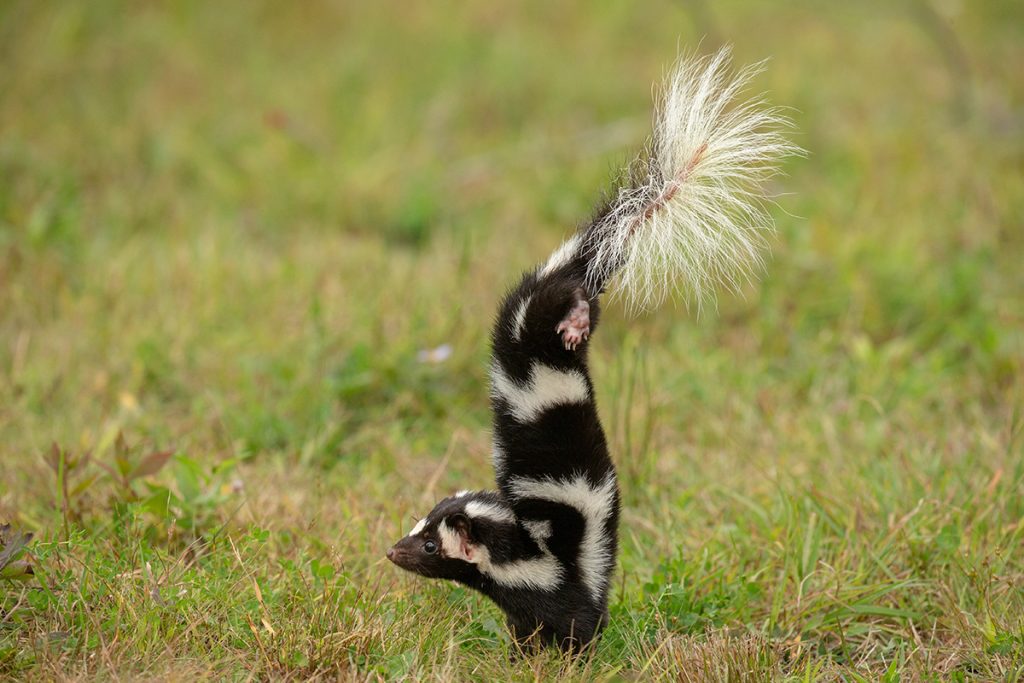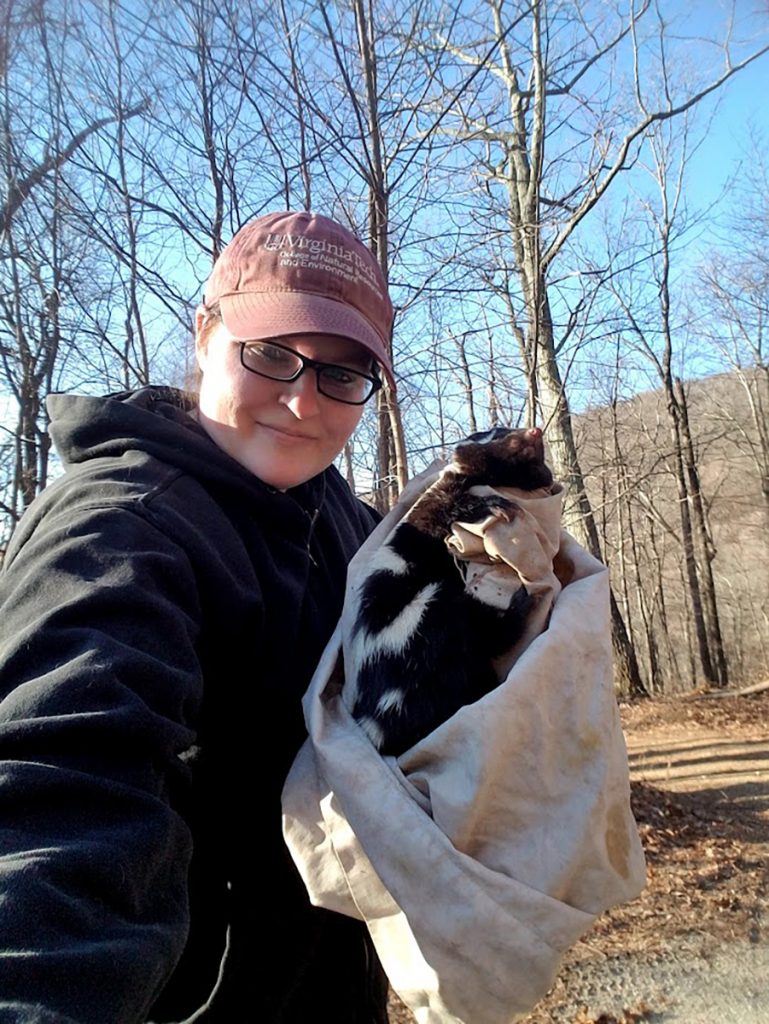
Contributing Writers | May 9, 2024 | No Comments

This gymnastic feat serves a purpose. If threatened, the spotted skunk will rise up on its front legs into a threatening handstand to scare away attackers. Adobe Stock Photo
A characteristic white stripe on a black pelt is an instant warning to tread gently. Nature’s stink bomb, the striped skunk carries this distinctive mark on its back. But Appalachia has a second variety of this master of malodor, marked instead by a blotchy pattern of black and white fur.
The Eastern spotted skunk, Spilogale putorius, was not always as rare as it is today. Decades ago, it was relatively common for trappers to catch the polecat, as it’s also known, for its pelt. But spotted skunk populations crashed between 1940 and 1970, according to a landmark paper from the University of Missouri looking at harvest data from trappers.By the 1980s, the study found, harvest numbers had plummeted by 99%, reflecting a steep decline in the skunk’s population.
Meanwhile, the spotted skunk’s striped cousin has thrived throughout the United States. So why have their populations diverged so drastically?
Emily Thorne spent six years collecting information about the distribution an habitat of eastern spotted skunks while pursuing a doctorate at Virginia Tech. She explains that there is a key difference in the habitat requirements of the two species.
“Stiped skunks are what we consider opportunistic and generalists,” Thorne says. “They can live pretty much anywhere and eat basically anything. And they’ve actually done really well and thrived in urban environments.”
According to Thorne, spotted skunks were at one point throught to be the same kind of generalists.
“But the more we learn about them, the more we realize they’re particular about their habitat,” Thorne says. “I suspect that they’re a conditional specialist where they require very specific habitat features, but during particular times of the year.”

Emily Thorne tracked spottd skunk populations in the Blue Ridge Mountains. Thorne is a trained researcher; members of the publi should not touch wild animals. Photo courtesy of Emily Thorne
Spotted skunks are much smaller than their striped counterparts. Males, on average, weigh about a pound and are 18 inches long, with a third of that being their tail. That makes them about five times smaller than the striped skunk and more vulnerable prey than their lumbering cousins.
For both species of skunks, the primary predator is the great horned owl and smaller owls. But the spotted skunk is more reliant on its habitat for protection.
“They prefer early succession to mid-succession hardwood forests, like mixed pine-hardwoods, specifically ones dominated by oak,” Thorne says. “They’ll den in tree cavities created by either rot or woodpeckers, and they’re almost always in oak trees.”
The skunks rely on areas with understory shrubs like mountain laurel and rhododendron as cover from predators, according to Thorne. She also found that their denning behavior changes with the seasons.
“During winter we almost always tracked them high up into trees,” Thorne says. “During the summer, when females have kits, they are always underground in a dirt burrow. We suspect that the temperature and humidity is a lot more stable, [and] they’re safe from predators.”
The next stage is a rocky outcrop whre the kits can run and still have easy access to cover.
“These conditional specialist requirements for habitat, depending on reproductive state and time of the year, were really cool, that we didn’t expect to find,” Thorne says.
The spotted skunk’s decline reflects the loss of its habitat. In a paper detailing the distribution of eastern spotted skunks in Virginia, they are mostly found in isolated populations west of the Blue Ridge Mountains at high and mid elevations. These colonies are small and patchy, Thorne reports, and habitat fragmentation has kept them separated.
Thorne estimates 20 to 30 skunks at the best habitat site she researched.
“Some of the higher elevation, less productive sites with less food, less habitat available, smaller habitat patches, it was probably around 10,” she says.
Despite reported decline, the Eastern spotted skunk is not federally listed as endangered, though some states do have protections. However, Thorne states that it is deserving of conservation attention. A major factor in establishing effective conservation efforts is learning where the skunks are.
If you see a spotted skunk in the woods, you can help researchers by reporting it at EasternSpottedSkunk.weebly.com.
The spotted skunk is a great hunter. These small carnivores will chase insects and small rodents and invade bird’s nests for their eggs.
• The skunk is itself hunted by bigger predators like bobcats, coyotes and owls.
• This critter has a unique defense strategy. If threatened, the spotted skunk will rise up on its front legs into a threatening handstand to scare away attackers. If that doesn’t work, the skunk has a scent sac from
which it can shoot a noxious stream of liquid. It not only stinks, but burns, similar to mace.
• Skunks are nocturnal, like their main predator, the great horned owl. They are more active on dark nights closer to the new moon than on full moon nights when they are more vulnerable to predators.
• There are four varieties of spotted skunks in Central America and North America. The Eastern spotted skunk is the only one in Appalachia.
Like this content? Subscribe to The Voice email digests